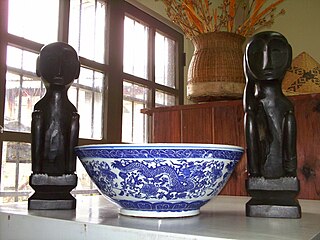Related Research Articles

A demigod or demigoddess is a part-human and part-divine offspring of a deity and a human, or a human or non-human creature that is accorded divine status after death, or someone who has attained the "divine spark". An immortal demigod(-dess) often has tutelary status and a religious cult following, while a mortal demigod(-dess) is one who has fallen or died, but is popular as a legendary hero in various polytheistic religions. Figuratively, it is used to describe a person whose talents or abilities are so superlative that they appear to approach being divine.
In Kapampangan mythology, Mayari is the goddess of the moon and ruler of the world during nighttime.

In the indigenous religion of the ancient Tagalogs, Bathala Maykapal was the transcendent Supreme Being, the originator and ruler of the universe. He is commonly known and referred to in the modern era as Bathala, a term or title which, in earlier times, also applied to lesser beings such as personal tutelary spirits, omen birds, comets, and other heavenly bodies which the early Tagalog people believed predicted events. It was after the arrival of the Spanish missionaries in the Philippines in the 16th century that Bathala Maykapal came to be identified with the Christian God, hence its synonymy with Diyos. Over the course of the 19th century, the term Bathala was totally replaced by Panginoon (Lord) and Diyos (God). It was no longer used until it was popularized again by Filipinos who learned from chronicles that the Tagalogs' indigenous God was called Bathala.

Philippine mythology is the body of stories and epics originating from, and part of, the indigenous Philippine folk religions, which include various ethnic faiths distinct from one another. Philippine mythology is incorporated from various sources, having similarities with Indonesian and Malay myths, as well as Hindu, Muslim, Shinto, Buddhist, and Christian traditions, such as the notion of heaven, hell, and the human soul. Philippine mythology attempts to explain the nature of the world through the lives and actions of heroes, deities, and mythological creatures. The majority of these myths were passed on through oral tradition, and preserved through the aid of community spiritual leaders or shamans and community elders.

Recent archaeological and other evidence suggests Hinduism has had some cultural, economic, political and religious influence in the Philippines. Among these is the 9th century Laguna Copperplate Inscription found in 1989, deciphered in 1992 to be Kawi script with Sanskrit words; the golden Agusan statue discovered in another part of Philippines in 1917 has also been linked to Hinduism.

Indigenous Philippine folk religions are the distinct native religions of various ethnic groups in the Philippines, where most follow belief systems in line with animism. Generally, these indigenous folk religions are referred to as Anito or Anitism or the more modern and less ethnocentric Dayawism. Around 0.2% of the population of the Philippines were affiliated with the so-called "tribal religions", according to the 2010 national census.
Buddhism is a minor religion in the Philippines. In 2016, Buddhism was practiced by around 2% of the population, according to the Permanent Mission of the Republic of the Philippines to the United Nations.

The Bakunawa is a serpent-like dragon in Philippine mythology. It is believed to be the cause of eclipses, earthquakes, rains, and wind. The movements of the Bakunawa served as a geomantic calendar system for ancient Filipinos and were part of the shamanistic rituals of the babaylan. It is usually depicted with a characteristic looped tail and a single horn on the nose. It was generally believed to be a sea serpent, but are also variously believed to inhabit either the sky or the underworld.

The Agusan image is a 2 kg (4.4 lb), 21-karat gold statuette, found in 1917 on the banks of the Wawa River near Esperanza, Agusan del Sur, Mindanao in the Philippines, dating to the 9th–10th centuries. The figure, approximately 178 mm (7.0 in) in height, is of a female Hindu or Buddhist deity, seated cross-legged and wearing a richly-adorned headdress and other ornaments on various parts of the body. It is now on display in the Field Museum of Natural History in Chicago.

Indigenous Philippine shrines and sacred grounds are places regarded as holy within the indigenous Philippine folk religions. These places usually serve as grounds for communication with the spirit world, especially to the deities and ancestral spirits. In some cases, they also function as safeguards for the caskets of ancestors, as well as statues or other objects depicting divine entities.
The nature of religion in the pre-colonial Philippines is often unclear. Religions present include animism, indigenous religious beliefs and mythologies such as Anito and influences from Hinduism and Buddhism. The earliest pieces of evidence that exist are archaeological finds including Hindu–Buddhist gold statues. The earliest written evidence comes from the Laguna Copperplate Inscription, dated to around 900 CE, which uses the Buddhist–Hindu lunar calendar. With the arrival of Islam in the 14th century, the older religions gradually disappeared, and after the arrival of Ferdinand Magellan in 1521 Christianity, specifically Roman Catholicism, became the dominant religion. However, some of the indigenous peoples of the Philippines continue to practice animism today, and many of the traditions in Anito have survived in the form of Folk Catholicism.
A dawn god or goddess is a deity in a polytheistic religious tradition who is in some sense associated with the dawn. These deities show some relation with the morning, the beginning of the day, and, in some cases, become syncretized with similar solar deities.

The indigenous religious beliefs of the Tagalog people were well documented by Spanish missionaries, mostly in the form of epistolary accounts (relaciones) and as entries in the various dictionaries put together by missionary friars.

Anito, also spelled anitu, refers to ancestor spirits, nature spirits, and deities in the indigenous Philippine folk religions from the precolonial age to the present, although the term itself may have other meanings and associations depending on the Filipino ethnic group. It can also refer to carved humanoid figures, the taotao, made of wood, stone, or ivory, that represent these spirits. Anito is also sometimes known as diwata in certain ethnic groups.

Tracy Maureen Perez is a Filipino model, industrial engineer and beauty pageant titleholder who was crowned Miss World Philippines 2021. She represented the Philippines at the Miss World 2021 pageant in San Juan, Puerto Rico and finished as a Top 13 semifinalist.
References
- ↑ H. Otley Beyer, "Outline Review of Philippine Archaeology by Islands and Provinces," Philippine Journal of Science, Vol.77,Nos.34 (July–August 1947),pp. 205-374
- ↑ "Agusan Gold Vajralasya". Philippine Heritage Collection. Field Museum of Natural History. Archived from the original on 2017-10-01. Retrieved 2019-01-07.
- ↑ Rahamann, R. (1955). "Quarrels and Enmity between the Sun and the Moon: A Contribution to the Mythologies of the Philippines, India, and the Malay Peninsula." Folklore Studies, 14, 202–214.
- ↑ Hill, Percy. A. (1934). Philippine Short Stories, p65. Stories reproduced in ISBN 971-542-083-4.
- ↑ POTET, Jean-Paul G. (2018). Ancient Beliefs and Customs of the Tagalogs. Lulu.com, 2018. ISBN 0244348731, 9780244348731. Page 166.